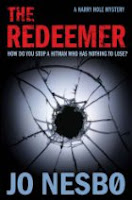 Published: Harvill Secker, 2005 (English translation: 2009)
Published: Harvill Secker, 2005 (English translation: 2009)ISBN: 9781846550409
First line: She was fourteen years old and sure that if she shut her eyes tight and concentrated she could see the stars through the roof.
It's nearly Christmas and a Salvation Army band is playing in one of Oslo's busiest streets. Suddenly, there is a shot and one of them falls down dead. It's obvious from the start that it is the work of a professional hit man; but why would anyone want to have a member of the Salvation Army murdered?
The hitman, a Croatian known as “the little redeemer”, a nickname he earned as a boy during the war against the Serbs, has his escape plans go terribly awry when bad weather delays his flight home. By the next day he has realised that he's killed the wrong man.
The police, in the meantime, have been able to discover both the gunman's identity, and his actual intended victim. The Redeemer, now a hunted fugitive, with no money, unable to use credit cards or mobile phone, and with just six bullets left, is determined to make good on the contract. There are many twists and turns as the police close in on the increasingly desperate gunman and the person who hired him.
The Redeemer is another wonderfully multi layered book in the Inspector Harry Hole series. The story is told partly from 'the little redeemer's' point of view, and through his eyes, we see the impact of the Croatian War of Independence which took place in the early 1990s . The Redeemer is both a product, and a victim of this terrible time in the history of the region. As we learn more about his background, our preconceived notions of good and bad are challenged. Are people who do bad things necessarily bad people?
Nesbo expertly juggles the various points of view, often using an intentionally confusing juxtaposition of the various characters' stories – cutting between them at similar points in the narrative. Nesbo cleverly misleads the reader again and again, but it is so well done that rather than feeling annoyed, you find yourself marvelling at how he does it.
Harry Hole goes about the investigation in his usual lone wolf style, using a combination of dogged police work and intuition that tends to put him at odds with his superiors. As the book opens, Harry's old boss and protector, Bjarne Moller, is transferring to a less stressful job in Bergen as a prelude to retirement. His new boss, Gunnar Hagen, has a military background and a fascination with Japanese military tactics. It's obvious he's not going to be happy with Harry's usual method of working.
Harry is one of the most intriquing characters in current crime fiction. He could be seen as just another in the long line of dour alcoholic loners who seem to populate fictional police forces worldwide, yet somehow Harry never seems like a cliché. Still struggling with his alcoholism, not always successfully, and not yet fully over the loss of a good friend and colleague in an earlier book, he is beginning to allow people into his life again. He still has warm feelings for his ex-girlfriend, and an almost fatherly attachment to her son.
This is the sixth in the Harry Hole series, although only the fourth to be available in English (the first two books are yet to be translated). As often happens, the books have been translated out of order, but newcomers to the series can now read books 3-6 in order, starting with The Readbreast. I would strongly recommend reading in order because of ongoing story elements.
Jo Nesbo has a very cool website that is worth a visit.







